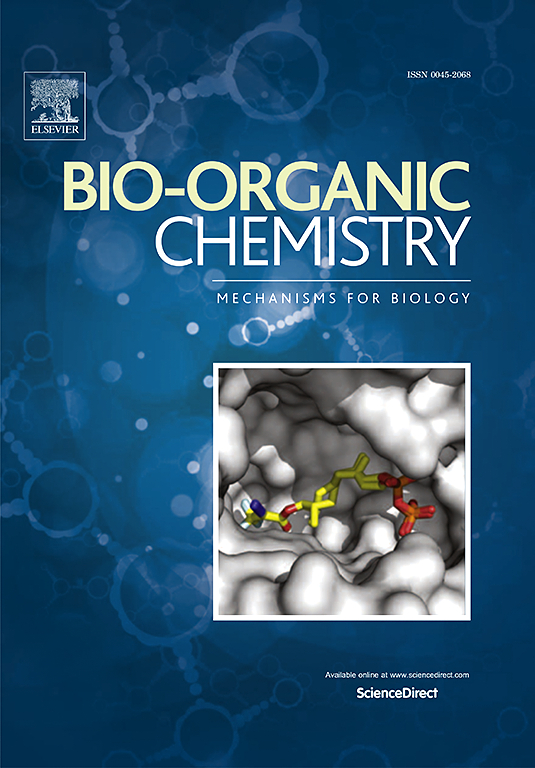Discovery of anti-MRSA carpatamides' congeners by heterologous expression along with their mechanism investigation targeting FabI and biofilm formation
IF 4.5
2区 医学
Q1 BIOCHEMISTRY & MOLECULAR BIOLOGY
引用次数: 0
Abstract
Methicillin-resistant Staphylococcus aureus (MRSA) remains a significant clinical challenge, necessitating the discovery of novel anti-MRSA agents. Previous bioinformatic analysis identified a candidate biosynthetic gene cluster (BGC) of ctd for carpatamides in Streptomyces parvus 1268. Through heterologous expression of ctd and subsequent fermentation and isolation, we have identified five novel carpatamide derivatives of carpatamides N − R (1–5), and a known compound of daryamide A (6). The structures and absolute configurations of compounds 1–6 were determined by ESI-HRMS, NMR, and ECD calculations. Compound 1 exhibited significant antitumor activity against non-small cell lung cancer cell line A549 with an IC50 value of 7.43 μM. Meanwhile, the antibacterial bioactivity results showed that carpatamides N − O (1–2) displayed excellent antibacterial bioassay against Gram-positive bacteria, including MRSA with MIC values of 0.5–2.0 μg/mL, outperforming vancomycin. Further mechanism investigation through molecular dynamics (MD) simulations and biofilm-related experiments suggests that compounds 1 and 2 may exert their anti-MRSA activity by inhibiting the function of NADPH-dependent enoyl-acyl carrier protein reductase (FabI) and the formation of biofilms of MRSA.

通过异源表达发现抗mrsa卡帕酰胺类同源物,并研究其靶向FabI和生物膜形成的机制
耐甲氧西林金黄色葡萄球菌(MRSA)仍然是一个重大的临床挑战,需要发现新的抗MRSA药物。先前的生物信息学分析鉴定出细小链霉菌1268中卡帕酰胺类生物合成基因簇(BGC)。通过ctd的异源表达和随后的发酵和分离,我们鉴定出了五种新的carpatamide N−R衍生物(1-5)和一种已知的daryamide a化合物(6)。化合物1 ~ 6的结构和绝对构型通过ESI-HRMS、NMR和ECD计算确定。化合物1对非小细胞肺癌细胞株A549具有显著的抗肿瘤活性,IC50值为7.43 μM。同时,抗菌生物活性结果表明,卡帕酰胺N−O(1-2)对革兰氏阳性细菌(包括MRSA)的抗菌生物活性较好,MIC值为0.5 ~ 2.0 μg/mL,优于万古霉素。通过分子动力学(MD)模拟和生物膜相关实验进一步的机制研究表明,化合物1和2可能通过抑制nadph依赖性烯酰酰基载体蛋白还原酶(FabI)的功能和MRSA生物膜的形成来发挥其抗MRSA活性。
本文章由计算机程序翻译,如有差异,请以英文原文为准。
求助全文
约1分钟内获得全文
求助全文
来源期刊

Bioorganic Chemistry
生物-生化与分子生物学
CiteScore
9.70
自引率
3.90%
发文量
679
审稿时长
31 days
期刊介绍:
Bioorganic Chemistry publishes research that addresses biological questions at the molecular level, using organic chemistry and principles of physical organic chemistry. The scope of the journal covers a range of topics at the organic chemistry-biology interface, including: enzyme catalysis, biotransformation and enzyme inhibition; nucleic acids chemistry; medicinal chemistry; natural product chemistry, natural product synthesis and natural product biosynthesis; antimicrobial agents; lipid and peptide chemistry; biophysical chemistry; biological probes; bio-orthogonal chemistry and biomimetic chemistry.
For manuscripts dealing with synthetic bioactive compounds, the Journal requires that the molecular target of the compounds described must be known, and must be demonstrated experimentally in the manuscript. For studies involving natural products, if the molecular target is unknown, some data beyond simple cell-based toxicity studies to provide insight into the mechanism of action is required. Studies supported by molecular docking are welcome, but must be supported by experimental data. The Journal does not consider manuscripts that are purely theoretical or computational in nature.
The Journal publishes regular articles, short communications and reviews. Reviews are normally invited by Editors or Editorial Board members. Authors of unsolicited reviews should first contact an Editor or Editorial Board member to determine whether the proposed article is within the scope of the Journal.
 求助内容:
求助内容: 应助结果提醒方式:
应助结果提醒方式:


